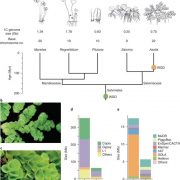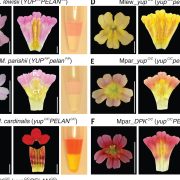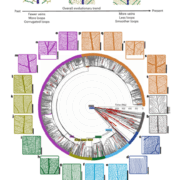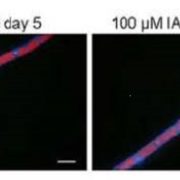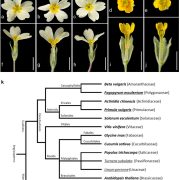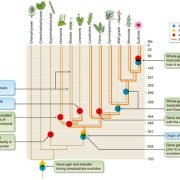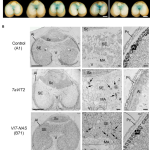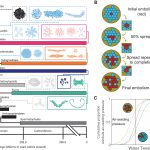To stripe or not to stripe in monkeyflower leaves
 In biology nothing makes sense but in the light of evolution. However, understanding how new traits can appear through modification of pre-existing elements has been a complex question in evolutionary biology. LaFountain et al. studied a population of a species of monkeyflower (Mimulus verbenaceus) which displayed a novel trait: a coloured leaf stripe. They found that this trait was controlled by a MYB transcription factor that they named STRIPY. This gene induces expression of enzymes in the anthocyanin synthesis pathway in the specific area of the stripe, leading to the observed phenotype. They cloned STRIPY from both striped and non-striped populations and showed that both alleles can drive anthocyanin production when expressed in Nicotiana benthamiana. In this way, they showed that both alleles are functional and the difference is due to a change in the expression pattern of STRIPY in the striped individuals. By generating mutants with altered stripe patterns, the authors demonstrated that other elements control the specific expression pattern of STRIPY in the leaf. They concluded that a network of genes determining the stripe pattern pre-existed and a change in the regulation of STRIPY caused it to be controlled by said network, leading to the observed phenotype. These findings support a model where evolution of new traits is possible through rewiring of pre-existing gene regulatory networks. (Summary by Ángel Vergara Cruces @ngelVerCru) New Phytol. 10.1111/nph.18486
In biology nothing makes sense but in the light of evolution. However, understanding how new traits can appear through modification of pre-existing elements has been a complex question in evolutionary biology. LaFountain et al. studied a population of a species of monkeyflower (Mimulus verbenaceus) which displayed a novel trait: a coloured leaf stripe. They found that this trait was controlled by a MYB transcription factor that they named STRIPY. This gene induces expression of enzymes in the anthocyanin synthesis pathway in the specific area of the stripe, leading to the observed phenotype. They cloned STRIPY from both striped and non-striped populations and showed that both alleles can drive anthocyanin production when expressed in Nicotiana benthamiana. In this way, they showed that both alleles are functional and the difference is due to a change in the expression pattern of STRIPY in the striped individuals. By generating mutants with altered stripe patterns, the authors demonstrated that other elements control the specific expression pattern of STRIPY in the leaf. They concluded that a network of genes determining the stripe pattern pre-existed and a change in the regulation of STRIPY caused it to be controlled by said network, leading to the observed phenotype. These findings support a model where evolution of new traits is possible through rewiring of pre-existing gene regulatory networks. (Summary by Ángel Vergara Cruces @ngelVerCru) New Phytol. 10.1111/nph.18486


